
•Year started: 2005
•Location : Sado City[1], Niigata Prefecture
•Actor : Sado Cit
The decline of crested ibises began in the 1900s as a result of uncontrolled hunting for their
beautiful feathers. They were reported to have become extinct in 1926, but when two ibises
were sighted in 1965, dedicated efforts toward their conservation was launched, including
breeding in captivity and the establishment of the Sado Ibis Protection Center in 1967.
However, after massive logging in the forests during and after World War II, the land was
cleared for farmland use. Agrichemicals were used for increased yield and the fields were
consolidated into large lots of farmland (drainage canals were lined with concrete), thereby
diminishing the organisms that the ibis fed on. As a result, despite conservation efforts, the
ibis population could not be recovered.
Sado is also famous for high-quality brand rice, Sado Koshihikari, which had once been
selling for a premium price, second only to the rice produced in Uonuma. Under these
circumstances, there had been no incentives to engage the rice producers of Sado in
environmentally-friendly agriculture. However, after the typhoon of August 2004 which
devastated the entire rice crop in Sado, the local rice could not resume its status in the
market, leaving 5,000 tons of rice unsold every year.
The drop of rice prices and stagnant sales heightened government pressure on production
adjustment, which Sado City feared would drive rice farmers to abandon their fields, leading
to the destruction of the Satoyama – home of the crested ibis. In this context, the city
launched the “Creating Villages Coexisting with Crested Ibis” program to certify that
products are made by environment-friendly agriculture methods which aim to “secure the
forage of the ibis” and to “produce biodiversity-friendly rice” in 2008. The ultimate aim of
this effort was to achieve the target stipulated in “Environment Restoration Vision” to
increase the ibis population in the eastern area of the island to 60 by 2015.
Sado City’s certification system, “Creating Villages Coexisting with Crested Ibis” requires
farmers to: 1) reduce the use of chemical pesticides and fertilizers to at least 50 percent of
conventional farming methods[2]; 2) adopt “agricultural technology fostering living
creatures”, which include the winter-flooding of rice paddies and the installation of
channels, fishways and biotopes; and 3) acquire certification as “eco-farmers[3]”
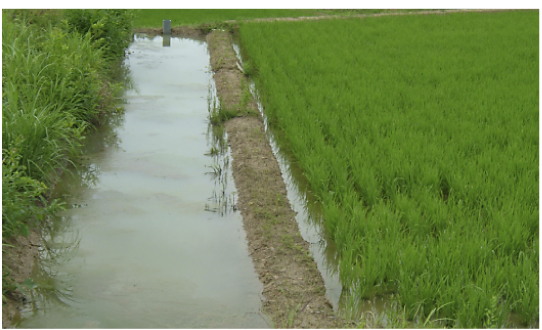
Photo: Setting fishways and ditches in paddies and drainage canals ©Sado City
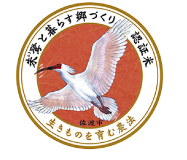 Sado City staff conduct on-site surveys to certify that a
rice paddy meets the requirements. The rice harvested
from certified fields are sold with the
"Toki-to-kurasu-sato" (villages coexisting with crested
ibis) label on internet retail stores and supermarkets and
rice stores in the Tokyo metropolitan area for 3,000-3,500
yen for a five-kilogram bag, compared to conventionally
grown rice which sell for 1,580 yen per 5 kilograms. Other
brands with certification are also emerging. For example,
Tokihikari (certified rice), produced by a voluntary group of
dedicated producers engaging in unplowed farming is sold
for 3,600-3,900 yen per 4.5 kilograms.
Sado City staff conduct on-site surveys to certify that a
rice paddy meets the requirements. The rice harvested
from certified fields are sold with the
"Toki-to-kurasu-sato" (villages coexisting with crested
ibis) label on internet retail stores and supermarkets and
rice stores in the Tokyo metropolitan area for 3,000-3,500
yen for a five-kilogram bag, compared to conventionally
grown rice which sell for 1,580 yen per 5 kilograms. Other
brands with certification are also emerging. For example,
Tokihikari (certified rice), produced by a voluntary group of
dedicated producers engaging in unplowed farming is sold
for 3,600-3,900 yen per 4.5 kilograms.
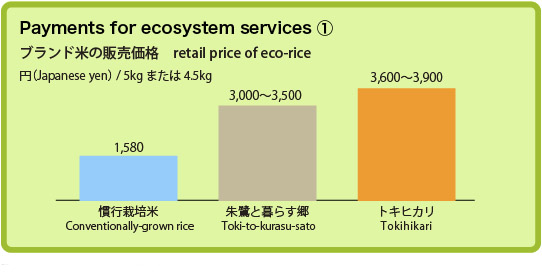
As a result, the Koshihikari-brand rice made in Sado gained higher recognition and the rice produced in 2008 sold out. More farmers came to adopt environmentally friendly agricultural methods, consequently engaging the entire island in reducing the use of pesticides and chemical fertilizers by 30 percent. Sado City aims to have all farmers on the island produce rice with half the amount of agrichemicals compared to conventional farming, which is also one of the requirements for "Creating Villages Coexisting with Crested Ibis"-certification.
The city grants 1,000 yen per 1,000m2 to support farmers acquiring certification and an additional 150 yen for every 60 kilograms sold in the market (with a maximum of 1,200 yen for 480 kilograms).
Farmers who grow certified rice have improved their income by 1,000 yen per bale of rice. Sales of certified rice have led to a larger number of living creatures in the paddies and increased feeding grounds for the ibis. With a working cycle of environmental and economic effects in place, the acreage of certified fields has also expanded from 420 hectares in 2008 to 860 hectares in 2009 and to 1,200 hectares in 2010 (on an application basis).
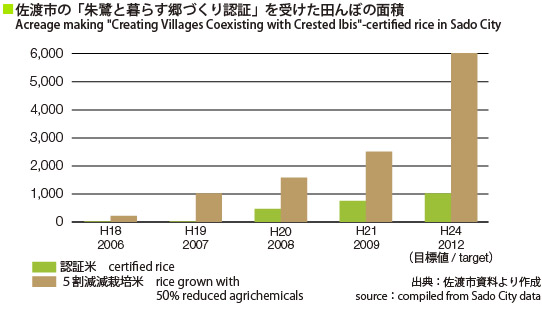
In 2010, the city designated the second Sunday of June and the first Sunday of August to be Rice Paddies Organism Survey Day, on which surveys are conducted in every rice field in the entire region to check the type and quantity of living creatures found. The findings will be mapped out and studied to see in which locations the crested ibis has fed. Through these activities, farmers will practice agriculture based on biodiversity conservation values and the city will guarantee safety.
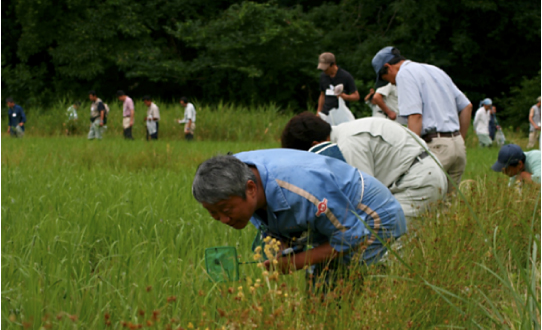
Photo: Rice paddy organism survey ©Sado City
For every kilogram of "Creating Villages Coexisting with Crested Ibis"-certified rice sold, 1 yen is contributed to the Fund for the Improved Habitat for Japanese Crested Ibis in Sado. Rice from the 2008 harvest, generated approximately 1.3 million yen in contributions which will be utilized to improve the habitat environment for the crested ibis. This effort is promoted for the purpose of connecting the producers, the retailers and the consumers under the shared hopes of conserving the crested ibis.
This movement has extended to rice that have not acquired certification, as well. In April 30, 2010 an agreement was signed by Sado City and the Japanese Consumers' Co-operative Union to donate to the Fund for the Improved Habitat for Japanese Crested Ibis, 1 yen for every kilogram of "Co-op Niigata Sado Koshihikari[4]" sold. This brand sells 2,650 tons (season of 2009 on brown rice-basis), the equivalent of 10 percent of the entire production in Sado and therefore, promises to generate 1.4 million yen of funds in the months of May through December in 2010. Through the sales of this brand rice, Sado City and the Cooperative Union will organize ways to raise awareness of the significance of biodiversity as well as tours to visit the producers in Sado and other events for enhanced mutual understanding between producers and consumers.
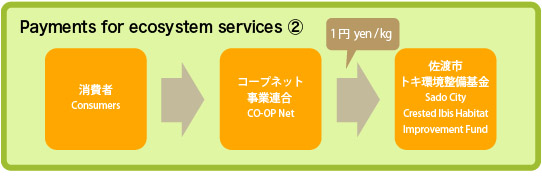
[1]Sado City covers the entire island of Sado, sitting in the Japan Sea, to the northwest of mainland
Niigata Prefecture. It has a population of about 60 thousand people on an area of 855.25 square
kilometers.
[2]Agricultural methods using a standard amount of agricultural pesticides and chemical fertilizers as
stipulated in regional guidelines determined by the local government.
[3]Farmers making integrated efforts for improving the soil and reducing the use of chemical fertilizers
and pesticides in accordance with the Law for Promoting the Introduction of Sustainable Agricultural
Production Practices are certified as Eco-farmers by the governor of each prefecture.
[4]The brand is sold by the eight cooperative societies of the Kanto and Shinetsu areas constituting
Co-op net mainly through home deliveries and in some stores. Some cooperative societies sell certified
rice as well. However, this program particularly addresses the co-ops leading product -Koshihikari
grown by conventional crop management.
•References
· Co-op net, Japanese Consumers Co-operative Union (2010) Expanding on donations and mutual
· exchange for the conservation of the crested ibis in Sado (press release)
· Japan Agricultural Communications (2010) Co-op net to donate 1 yen to crested ibis conservation for
every kilo of rice sold
· Katada, Megumi and Tanaka Hiroto (2008) Valuing the low fertilizer and agricultural chemical rice
produced in creating a habitat for returning Japanese ibis. Agricultural Information Research
17:6-12
· Saito, Shinichiro(2009)Living with the crested ibis! Towards an island with biodiversity (speech given at
breakfast meeting of Business Leaders Inter-forum for Environment 21 on December 15, 2009)
•Special thanks to
Sado City (Biodiversity Promotion Office, Agriculture, Forestry and Fisheries Division)


